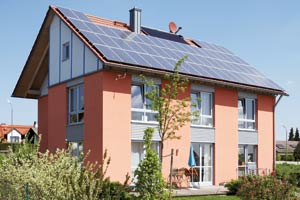Current
informs.
All news at a glance.

We keep you up to date
We bring you the latest developments and news directly to your screen!
Current dates and developments always in view.
Zero tax rate for the supply of solar systems
The tax authorities have published detailed regulations on VAT exemption for the supply of new photovoltaic systems from 2023.
From 2023, VAT will no longer apply to the supply, installation, intra-Community acquisition and import of photovoltaic systems and electricity storage systems. The prerequisite for the application of the zero tax rate to photovoltaic systems is that the system is installed on or in the vicinity of dwellings or buildings used for activities serving the common good or that the installed gross output of the photovoltaic system does not exceed 30 kW(p) according to the Market Master Data Register (MaStR). The tax authorities have now regulated in more detail when the requirements are met, how they are to be proven, which special features apply to certain systems and which simplification regulations are available.
The regulations are not only important for buyers of photovoltaic systems who want to save VAT. They are even more important for the sellers of the systems, who are exposed to considerable tax liability risks with regard to VAT if they do not correctly check the requirements for the zero VAT rate and are unable to prove compliance in case of doubt. In any case, it is advantageous that the installation is also subject to a zero rate of VAT in the case of preferential systems, so that suppliers do not have to differentiate between supply and service elements.

Another positive aspect for suppliers is that, according to the amended regulations in the VAT application decree, they can be satisfied with a declaration from the buyer and therefore generally do not need to make any further inquiries. Nevertheless, suppliers should also include a contractual provision in the event that the buyer provides false information or the declaration later turns out to be incorrect. There is no provision for the protection of legitimate expectations in this case. Here is an overview of the tax authorities' requirements:
-
Beneficiary solar modules: The zero tax rate applies to all grid-connected systems and non-grid-connected stationary systems (so-called stand-alone systems). This means that balcony power plants are also eligible because they are usually connected to the grid via a socket, but not small mobile solar modules, such as those offered for camping purposes. For reasons of simplification, it can be assumed that solar modules with an output of 300 watts and more are used for grid-connected systems or stationary stand-alone systems. Stationary solar modules that fulfill other insignificant secondary purposes in addition to electricity generation are also eligible (e.g. solar tables). Hybrid modules that produce both electricity and heat are also eligible.
-
Battery storage: Batteries and storage systems are subject to the zero tax rate if they are intended to store electricity from eligible solar modules in the specific application. Subsequent changes in the use of batteries and storage systems are irrelevant for the zero tax rate.
-
Essential components: In addition to the solar modules and the battery storage system - installed at the same time or subsequently - other essential components of the photovoltaic system are also subject to the zero tax rate. These include items whose intended use is specifically in the operation or installation of photovoltaic systems or which are necessary to meet technical standards, e.g. inverters, roof mounts, energy management systems, solar cables, feed-in sockets (so-called Wieland sockets), radio ripple control receivers, backup boxes and equipment used for emergency power supply. The subsequent delivery of individual essential components and their spare parts, as well as their installation, are also subject to the zero rate if they are intended for a system that meets the requirements of the zero rate. However, accessories such as screws, nails and cables do not count as essential components, even if these parts are necessary for the installation of the system, unless such accessories are part of a uniform supply by a supplier and therefore an ancillary supply that shares the fate of the main supply. Similarly, electricity consumers for the newly generated electricity (charging infrastructure, heat pump, hydrogen storage, etc.) are not part of the main components.
-
Installation: The installation of photovoltaic systems is also subject to the zero tax rate if the supply of the installed components meets the requirements for the zero tax rate. The tax-privileged services include photovoltaic system-specific work that is used exclusively to operate a photovoltaic system safely for the building and for the people in it. The installation work must be carried out directly for the system operator in order to qualify for the tax rate reduction. (Preliminary) work that also benefits other electricity consumers or generators or other purposes, on the other hand, is not subject to the zero rate, unless it is part of a uniform supply as an ancillary supply to which the zero rate applies. As long as the supplier of the photovoltaic system offers other services (e.g. roof work, electrical installation, etc.) as part of a uniform package solution, the central element of which is the supply of a subsidized photovoltaic system, the zero rate can therefore also be claimed for services that would otherwise be subject to the standard rate of tax.
-
Fringe benefits: Supplies and other services that have no purpose of their own for the purchaser, but serve to make use of the supply of the photovoltaic system under optimal conditions, share the fate of the photovoltaic system and are also taxable as ancillary services at the zero tax rate. Ancillary services include the transfer of the registration to the MaStR, the provision of software for controlling and monitoring the system, the assembly of the solar modules, the cable installations, the supply and connection of the inverter or the bidirectional meter, the supply of screws and power cables, the production of the AC connection, the provision of scaffolding, the supply of mounting materials or the replacement of the meter cabinet if this is required by the grid operator or is necessary for the operation of the system due to technical standards. The prerequisite for the zero tax rate is that such ancillary services are provided by the supplier of the photovoltaic system as part of a uniform overall service.
-
Hire, installment plan & leasing: The rental of a photovoltaic system is not a supply and is therefore subject to the standard tax rate. In contrast, leasing or hire-purchase agreements can be classified as either a supply or other service, depending on their specific structure. The contractual agreements on the term, payment terms and possible combinations with other service elements are decisive for the distinction. The zero tax rate does not apply to the part of the remuneration that is attributable to independent services such as maintenance work, obtaining official permits or insuring the photovoltaic system. A uniform rental amount is to be divided according to the simplest possible method. For installment plan and leasing contracts that are to be classified as a delivery and that do not provide for an apportionment of the consideration, an apportionment must be made on the basis of the internal calculation if the photovoltaic system was delivered after December 31, 2022. Alternatively, a flat-rate ratio of 90 % for the provision of the photovoltaic system and 10 % for other services can be applied.

-
Property developer: The supply of rooftop photovoltaic systems by property developers is also subject to the zero tax rate, even if the property developer also supplies the building in addition to the rooftop photovoltaic system, as the supply of the rooftop photovoltaic system is an independent service and not a dependent ancillary service to the supply of the building.
-
Operator: The zero tax rate only applies to the supply to the operator of a photovoltaic system. The preceding supplies to intermediaries, the lessor or other entrepreneurs are subject to the standard tax rate. The operator is the person or partnership that would be required to register as the operator of the respective system under the MaStR at the time of supply. Actual registration, feed-in or a subsidy under the EEG are not relevant. It is sufficient if the system is to be connected directly to the electricity grid. The entrepreneurial status of the operator is not a prerequisite for the zero tax rate. Subsequent changes to the operator are also irrelevant. If there is no obligation to register in the MaStR (stand-alone system), the zero tax rate can still be applied. In this case, for reasons of simplification, it must be assumed that the recipient of the service is the operator of the photovoltaic system.
-
Location: The application of the zero tax rate requires the installation of solar modules and other components on or near dwellings or public and other buildings used for activities serving the common good. A dwelling is any enclosed space that is used for living or sleeping. Buildings on recreational land and gazebos in allotment garden settlements are therefore also considered dwellings. Caravans and houseboats, on the other hand, are only to be regarded as dwellings if they are not moved or are only moved occasionally. Containers can also fulfill the definition of buildings required for the application of the zero tax rate if the other requirements are met (e.g. school containers). A photovoltaic system is located in the vicinity of dwellings or buildings in particular if it is installed on the property on which the dwelling or the beneficiary building is located. Proximity can also be assumed if there is a spatial or functional connection of use between the property and the photovoltaic system (e.g. uniform building complex or uniform area).
-
Simplification rule: The location requirements are deemed to be met if the installed gross output of the photovoltaic system is or will be no more than 30 kW(p) according to the MaStR. The simplification rule only relates to the verification of the type of building or location, but not to the verification of the operator status of the recipient of the supply. If there is no obligation to register in the MaStR, the simplification rule does not apply. The 30 kW limit must be checked on a unit basis. If a photovoltaic system is subsequently extended, the output of the existing unit must be added to the output of the extension. If the 30 kW limit is exceeded by the extension, the simplification rule does not apply to the subsequently added part. However, this does not mean that the simplification rule does not subsequently apply to the existing part.
-
Mixed-use buildings: If a building is used for both tax-privileged and non-preferential purposes, the building is generally deemed to be tax-privileged as a whole. The only exceptions to this are buildings where the non-preferential use is so subordinate to the non-preferential commercial or other use that it would not be appropriate to apply the preferential treatment and thus the zero tax rate. This is the case if the proportion of usable floor space attributable to the non-harmful use is less than 10 % of the total building floor space or if the non-harmful use is closely related to the harmful use and has no independent purpose (e.g. janitor's apartment in a commercial complex).
-
Proof by the supplier: The supplier must prove that the conditions for applying the zero tax rate are met. It is sufficient for proof if the purchaser declares that he is the operator of the photovoltaic system and that it is either a tax-privileged building or that the installed gross output of the photovoltaic system does not exceed 30 kW(p) according to the MaStR. Such a declaration by the purchaser can also be made as part of the contractual agreement (e.g. in the general terms and conditions). The same applies to subsequent deliveries of storage systems, essential components and spare parts.
-
Micro installations: If the output of the photovoltaic systems does not exceed 600 watts, the supplier is not required to prove that the conditions for the zero tax rate are met. It is also assumed that the customer is the operator. However, this does not apply to supplies by manufacturers of photovoltaic systems and wholesale supplies.
-
Maintenance contracts: The standard tax rate of 19 % continues to apply to guarantee and maintenance contracts for photovoltaic systems, as this is a miscellaneous supply and not a supply of solar modules and accessories.
-
Entrepreneurship: Despite the zero tax rate, the purchaser of a photovoltaic system is still an entrepreneur for VAT purposes if they feed electricity into the public grid and receive remuneration for this. Although this remuneration is exempt from income and trade tax, this or the intention to make a profit are not relevant for VAT purposes. The operator must therefore continue to register for VAT with the tax office and submit VAT returns because the zero tax rate only applies to the purchase of the system, but not to the supply of the electricity generated by the system to a grid operator. However, if the operation of the photovoltaic system is the only activity subject to VAT, this expense can be avoided with the small business regulation. Even in the past, the only reason for pure photovoltaic system operators to waive the small business regulation was generally the possibility of deducting input tax when purchasing the system. However, as the zero tax rate now applies to the purchase, installation and spare parts, there is no longer any reason for system operators to waive the small business regulation.